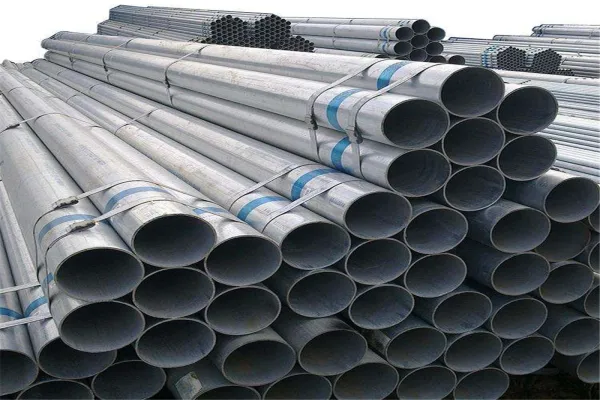The surface quality of galvanized steel pipes is an important indicator for measuring their corrosion resistance and appearance quality. The uniformity, thickness and integrity of the galvanized layer all affect the service life of the steel pipe. Depending on the chemical composition, process conditions and environmental factors, the surface of the galvanized steel pipe may present different states. The following lists the common surface characteristics of galvanized steel pipes and their effects.
1. Gray and dark-gray cobwebbing
The chemical elements of the steel tube such as C, Si, P and Mn will cause Fe-Zn alloy reaction with the increase of the content, produced zinc-iron alloy layer on the coating surface, especially with Si increased, which accelerate the reaction of iron-zinc melt mutually, formed on the surface of gray even the black net. The black coating layer is thicker than the bright coating, the corrosion protection and prevention ability completely inferior to the bright coating, but will be more resistant to corrosion but may not pretty sensually. Hot-dipped galvanized pipe will inevitably turn to dark color after a short period of time.
ASTM123, JISH8641, BS729 and other standards specified that the gray coating does not affect the corrosion resistance of the galvanized layer. The new version of the BS ENISO1461:1999 standard is more clear and added the following: "as long as the minimum coating thickness greater than the pipe surface to be galvanized, even in the presence of dark gray areas (such as dark gray mesh pattern area) or some uneven surface should not be considered a reason for rejection"
2. Coating surface roughness
The rough zinc layer is usually due to the uneven growth of Zn-Fe alloy. Because the uneven distribution of chemical elements in steel pipe and the different thickness of zinc iron alloy layer generated, make the surface roughness after galvanization. But it does not affect the use, but if the customer has a special requirement in advance, it should ask the advice of the galvanizing expert and choose the material with uniform composition and good gloss on the surface.
Zinc and water flow traces.During the first minute of immersion in the galvanizing bath,zinc-iron alloy layers grow rapidly on the surface of the steels which are most commonly galvanized.The excess zinc solution will accumulate in some areas where zinc is not smooth, creating zinc and water traces. This will not affect the use of the coating, on the contrary will form a thick coating to enhance the anti-corrosion ability. If the customers have special requirements in this respect, they should consult with the galvanizing manufacturers for the special design and treatment of zinc.
Zinc tumor. Mainly from the zinc zincilate (a kind of suspended Zn-Fe alloy galvanized steel pipe adhesion on the surface), galvanized layer can be showed completely when the zine tumor removed. Its corrosion resistance is equivalent to that of the general zinc layer. A small amount of dispersed zinc nodules is not harmful to the surface of the coating, but too much and too much zinc tumor will seriously damage the smoothness and appearance of the coating.
3. White Rust: Causes and Prevention
White rust is a common issue that occurs during the storage and transportation of galvanized steel tubing. It appears as a white, powdery substance on the surface and is primarily composed of alkaline zinc oxide.
Cause: White rust forms when galvanized steel is exposed to moisture and poor ventilation, particularly in overlapping or tightly packed storage conditions.
Impact on Performance: While white rust may appear unsightly, it has minimal impact on the corrosion resistance and service life of the galvanized layer. If the coating thickness remains within standard requirements after removing the white rust, the tubing is still acceptable for use.
Prevention and Treatment:
3.1.Storage and Transportation: Ensure that the tubing is stored in a dry, well-ventilated environment. Avoid overlapping stacking and cover the upper part of the tubing to prevent moisture accumulation.
3.2.Passivation Treatment: Applying a passivation solution after galvanization can significantly reduce the risk of white rust formation.
4. Best Practices for Maintaining Galvanized Steel Tubing
To ensure the longevity and performance of galvanized steel tubing, it is essential to follow best practices during production, storage, and transportation:
Material Selection: Choose steel with a uniform chemical composition to minimize surface roughness and uneven coating.
Galvanizing Process: Work with experienced galvanizing manufacturers to optimize the process and address specific customer requirements.
Storage Conditions: Maintain a dry and ventilated storage environment to prevent white rust and other moisture-related issues.
Regular Inspection: Conduct regular inspections to ensure the coating thickness and surface quality meet industry standards.

5. Conclusion
The surface conditions of
galvanized steel tubing, such as gray cobwebbing, roughness, and white rust, are influenced by various factors, including the chemical composition of the steel and environmental conditions during storage and transportation. While these conditions may affect the appearance of the tubing, they often have minimal impact on its corrosion resistance and performance. By adhering to industry standards and implementing best practices, manufacturers and users can ensure the optimal quality and longevity of galvanized steel tubing.
For more information on galvanized steel tubing and its applications, consult with industry experts or refer to relevant standards such as
ASTM123, JISH8641, and BS ENISO1461:1999.






 English
English Español
Español بالعربية
بالعربية











 Phone :
Phone :  Whatsapp :
Whatsapp :  Email :
Email : 


